Don’t Let Inflation Wreck Your Returns
![]() Inflation Is Sapping Your Investment Returns
Inflation Is Sapping Your Investment Returns
 If you’d plunked down $1,000 into an S&P 500 index fund on this day five years ago… how much money would you have now?
If you’d plunked down $1,000 into an S&P 500 index fund on this day five years ago… how much money would you have now?
The index stood at 2,962 then. Going into this morning, it was 5,702. So you’d be sitting on $1,925. You’d have almost doubled your money.
Not bad, right?
 But hold on: What’s your gain after you adjust for inflation?
But hold on: What’s your gain after you adjust for inflation?
That’s not an academic question. Inflation affects not just the cost of gas and groceries, but the value of your investments.
After all, the money you’re putting into the market today is money you’re counting on to live better in the future, right?
So in reality, your gain isn’t as impressive: After inflation, the $1,000 you put into the market five years ago is worth $1,563.
Still not bad — but not nearly as good as if inflation weren’t a factor.
 But hold on again: It can get worse. Much worse.
But hold on again: It can get worse. Much worse.
“You can be long stocks in a rising stock market and still lose enormous wealth in real terms,” says Paradigm’s macroeconomics maven Jim Rickards.
The reason? “Your stocks are denominated in dollars and the dollar itself can lose value even as the dollar value of stocks is going up.
“The easiest way for the dollar to lose value is inflation (purchasing power), but there are other ways including the dollar value of gold (the best form of money) and foreign exchange markets. This type of loss sneaks up on investors because they see major stock indexes going up 10% or 20% without realizing the dollar itself might be crashing by 50% or more.”
 How bad can it get? Let’s rewind to the inflationary 1970s — soaring meat prices, gas lines, President Carter wearing a cardigan sweater while cranking down the thermostat.
How bad can it get? Let’s rewind to the inflationary 1970s — soaring meat prices, gas lines, President Carter wearing a cardigan sweater while cranking down the thermostat.
In the stock market, the Dow industrials approached a record 1,000 in 1966. But that’s as good as it got until the early 1980s.
For 14 years, the Dow kept bumping up against that barrier, unable to break through. Not until 1982 was the index able to leave 1,000 behind for good.
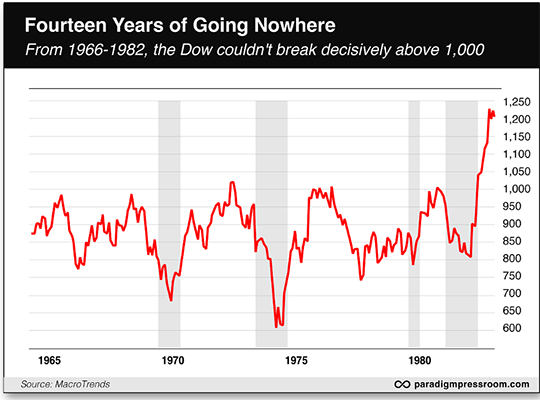
That’s bad enough, right? But when you factor in the inflation of the 1970s the results are much, much worse. Think about it: 1,000 on the Dow in 1982 wasn’t nearly as valuable as 1,000 on the Dow in 1966.
Here’s the same chart once you adjust for the inflation rate…
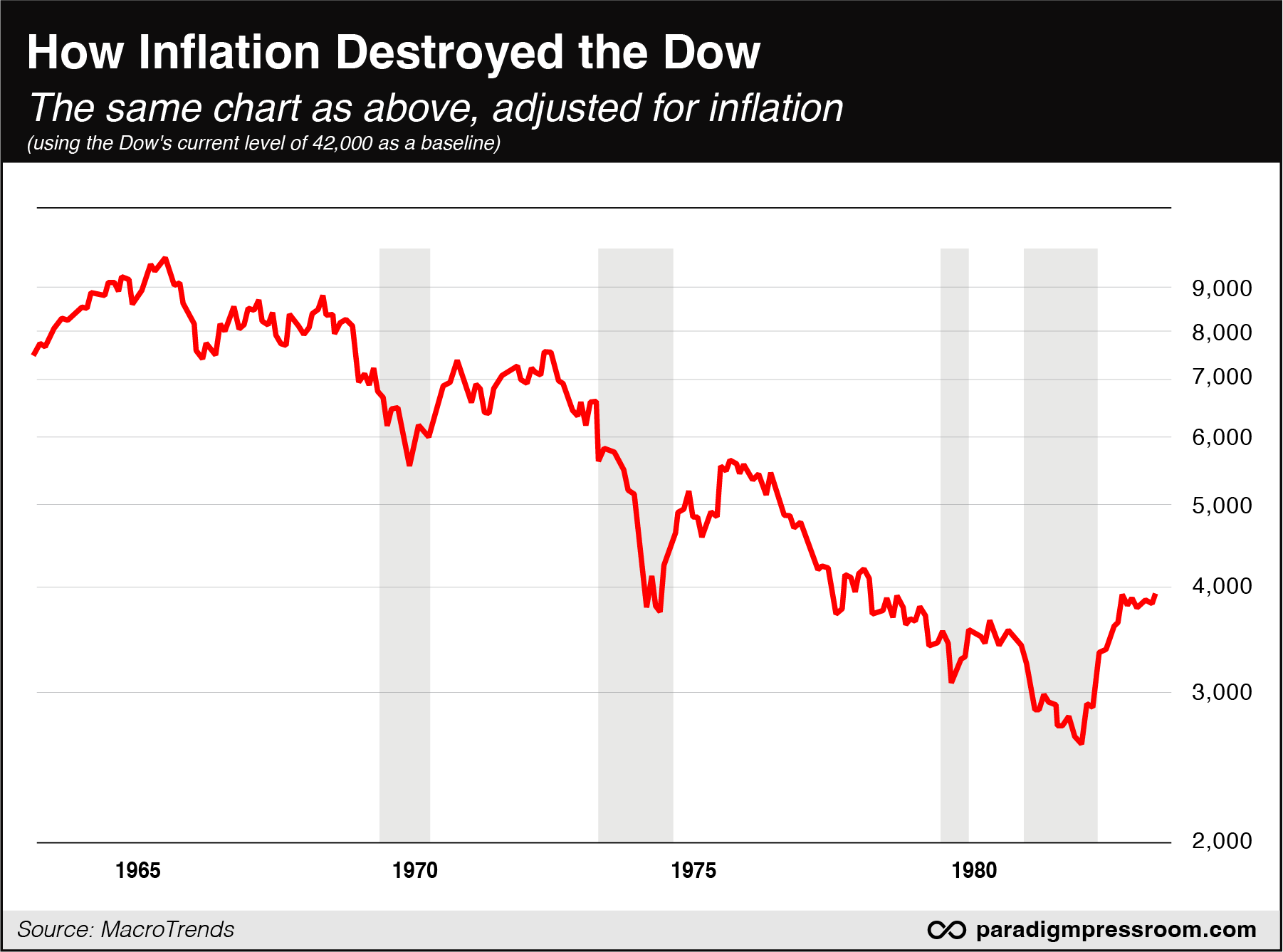
In fact, if you’d put $1,000 into the Dow stocks in 1966, you wouldn’t have broken even — not in terms of your purchasing power — until 1995, almost three decades later!
 Yes, the 1970s are an extreme example. But hopefully, you now see how the erosion of the dollar’s purchasing power can cut into your investment returns — sometimes by a substantial amount.
Yes, the 1970s are an extreme example. But hopefully, you now see how the erosion of the dollar’s purchasing power can cut into your investment returns — sometimes by a substantial amount.
“Real stock values are driven by factors that are much larger than stock fundamentals and interest rates,” Jim sums up.
“They are driven by inflation, deflation, currency fluctuations and business cycles. Investors need to be aware of these cross-currents in setting their portfolio allocations. Simply cheering on higher index levels is not enough.”
Remember what we’ve pointed out for a couple of years now: The historical evidence suggests it won’t be until at least 2030 before the United States returns to “normal” 2% inflation.
Unlike the last 15 years, a secure future and comfortable retirement will now require substantial outperformance of the broad stock market.
![]() T-Minus Eight Days Till a Dockworker Strike
T-Minus Eight Days Till a Dockworker Strike
 It’s now only eight days before East Coast and Gulf Coast dockworkers will likely go on strike.
It’s now only eight days before East Coast and Gulf Coast dockworkers will likely go on strike.
The International Longshoremen’s Association is still at an impasse with the U.S. Maritime Alliance. The contract for 45,000 workers expires a week from today. The two sides are far apart on everything from pay to automation.
“A sleeping giant is ready to roar on Tuesday, Oct. 1, 2024, if a new Master Contract Agreement is not in place,” union president Harold Daggett said last week.
As we’ve mentioned before, a one-day strike will foul up supply chains for a week. A one-week strike will have downstream effects for a month — at the very time retailers are stocking up for the holidays.
The consumer will feel the impact of anything lasting longer than “a couple days,” says National Retail Federation’s Jonathan Gold.
While the Biden administration intervened to stop a freight rail strike ahead of the 2022 midterm elections — and helped negotiate a new contract for West Coast dockworkers last year — it appears the White House will stay hands-off this time.
Yes, there is an election subtext, according to Bloomberg: “The union has warned the White House against getting involved. It has withheld endorsing a presidential candidate, though, according to Daggett, former President Donald Trump, ‘promised to support the ILA in its opposition to automated terminals’ during a Mar-a-Lago meeting last fall.”
 As for the markets today, the S&P 500 is inching back into record territory — up a third of a percent at last check to 5,720.
As for the markets today, the S&P 500 is inching back into record territory — up a third of a percent at last check to 5,720.
Gold is also in the green, up $10 to $2,631. But silver is losing ground, back below $31. Bitcoin continues to hold the line on $63,000.
Crude is not reacting to the widening war between Israel and Hezbollah in Lebanon — a barrel of West Texas Intermediate up about a quarter to $71.29.
The only major economic indicator due this week comes Friday when the Commerce Department issues its latest read on “core PCE” — the Federal Reserve’s preferred measure of inflation.
![]() Musk Folds on Free Speech
Musk Folds on Free Speech
 It’s not the first time, but Elon Musk just totally caved on free speech.
It’s not the first time, but Elon Musk just totally caved on free speech.
After being banned in Brazil for the last three weeks, X-formerly-Twitter says it’s now complied with orders from Brazil's Supreme Court in hopes the ban will be lifted.
“The decision was a surprise move by Mr. Musk, who owns and controls X, after he said he had refused to obey what he called illegal orders to censor voices on his social network,” says The New York Times. “X’s lawyers said the company had done exactly what Mr. Musk vowed not to: take down accounts that a Brazilian justice ordered removed because the judge said they threatened Brazil’s democracy.”
In case you’re not aware, Brazil is something of a test tube for censorship in the Western-adjacent developing world. Enforcement is by and large a one-man show — led by a Supreme Court justice named Alexandre de Moraes.
Moraes has proven to be quite the political chameleon. When nominated to the high court in 2017, Brazil’s left denounced him as a fascist and racist. But seven years later, he’s hailed by the left as a hero for draconian censorship measures targeting “disinformation” — measures far beyond anything attempted by the U.S. government to date.
When X refused to carry out Moraes’ censorship orders three weeks ago, he ordered the platform banned in Brazil — a ban so sweeping that any Brazilian trying to access it through a VPN was subject to fines of up to $9,000 a day. (Which is a far bigger sum of money for the typical Brazilian than it is for even the typical American.)
 It’s at this time we’ll remind you once more that as a free speech advocate, Elon Musk is fatally compromised — even, or especially, in the United States. He has to stay in the good graces of the U.S. government to keep Tesla’s tax breaks and SpaceX’s federal contracts.
It’s at this time we’ll remind you once more that as a free speech advocate, Elon Musk is fatally compromised — even, or especially, in the United States. He has to stay in the good graces of the U.S. government to keep Tesla’s tax breaks and SpaceX’s federal contracts.
Time and again, the accounts of everyday Americans on X get restricted or nuked altogether for the most arbitrary of reasons. But the common thread is that the accounts say something that runs afoul of conventional wisdom within the U.S. power elite.
The civil libertarian Glenn Greenwald — who’s split his time between the United States and Brazil for the last 20 years or so — describes the state of play like this: “The problem is governments will be able to fully censor and control the internet until all Big Tech platforms unite against it.”
Good luck with that. As we saw only last week, Facebook/Instagram parent Meta has already failed its first test of Mark Zuckerberg’s newfound commitment to free speech…
![]() Silver at $100 an Ounce!
Silver at $100 an Ounce!
 We’re used to seeing silver coins sold at crazy markups. But…
We’re used to seeing silver coins sold at crazy markups. But…
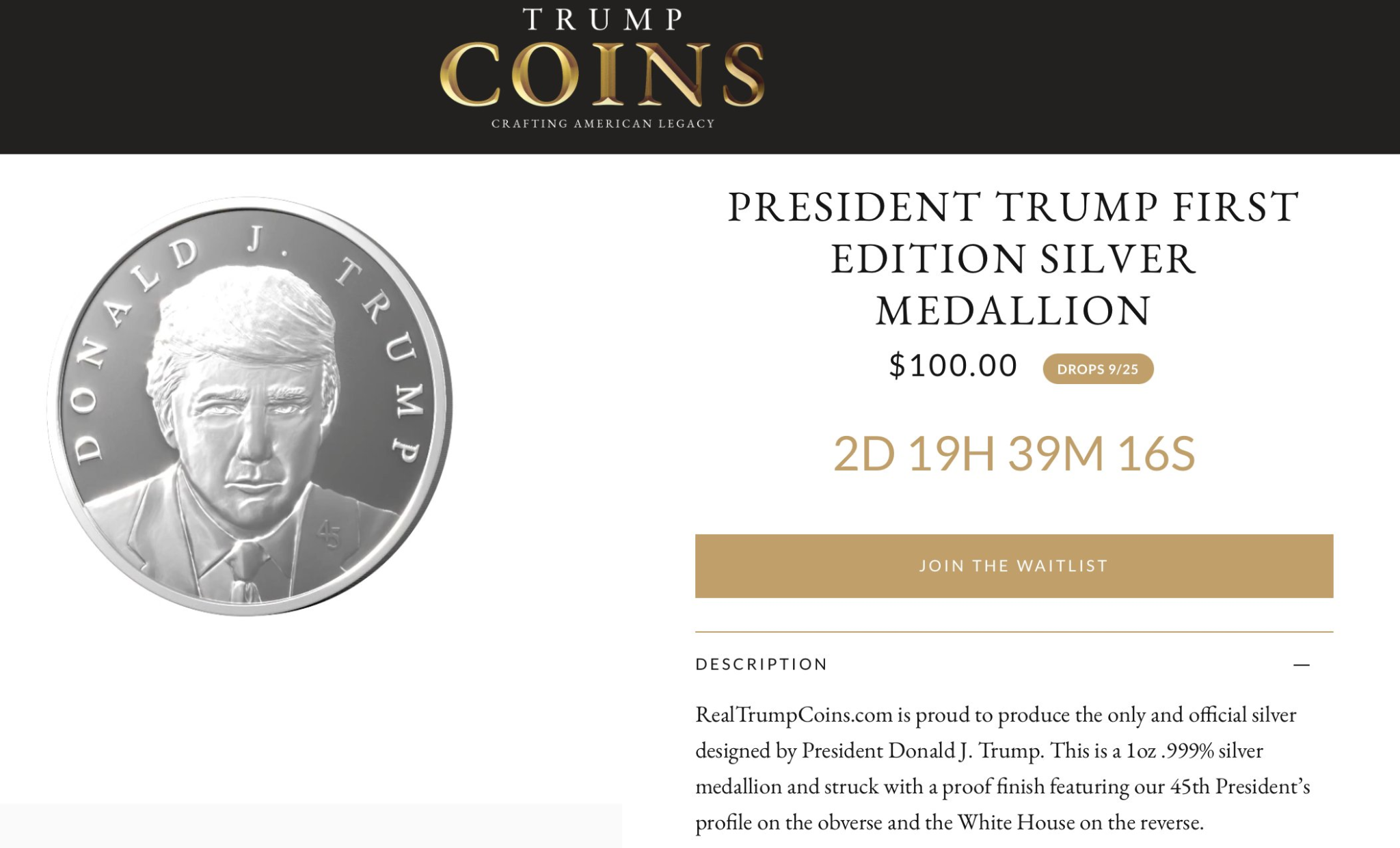
OK, we’ll get to the $100 price tag for these Trump silver “medallions” shortly. (Reminder: Silver trades for under $31 today.)
But even before that we’re floored by the description that says the coin consists of “.999% silver” — which suggests there’s almost no silver in it.
Presumably these coins are something on the order of 99.9% silver, much like a U.S. Silver Eagle or a generic silver round.
What do you get for your $100? The website says the coins are "intended as collectible items for individual enjoyment, and not for investment purposes" and "the coins are not political and have nothing to do with any political campaign."
Well, as long as you know what you’re getting into…

Anyway, the coins go on sale Wednesday.
![]() Mailbag: Inflation
Mailbag: Inflation
 A reader has a bone to pick with the inflation chart we shared in Thursday’s special edition, featuring Jim Rickards’ commentary on the heels of the Federal Reserve’s rate-cut decision.
A reader has a bone to pick with the inflation chart we shared in Thursday’s special edition, featuring Jim Rickards’ commentary on the heels of the Federal Reserve’s rate-cut decision.
Here, for reference, is the chart, showing how the inflation rate has been falling for several months in a row…
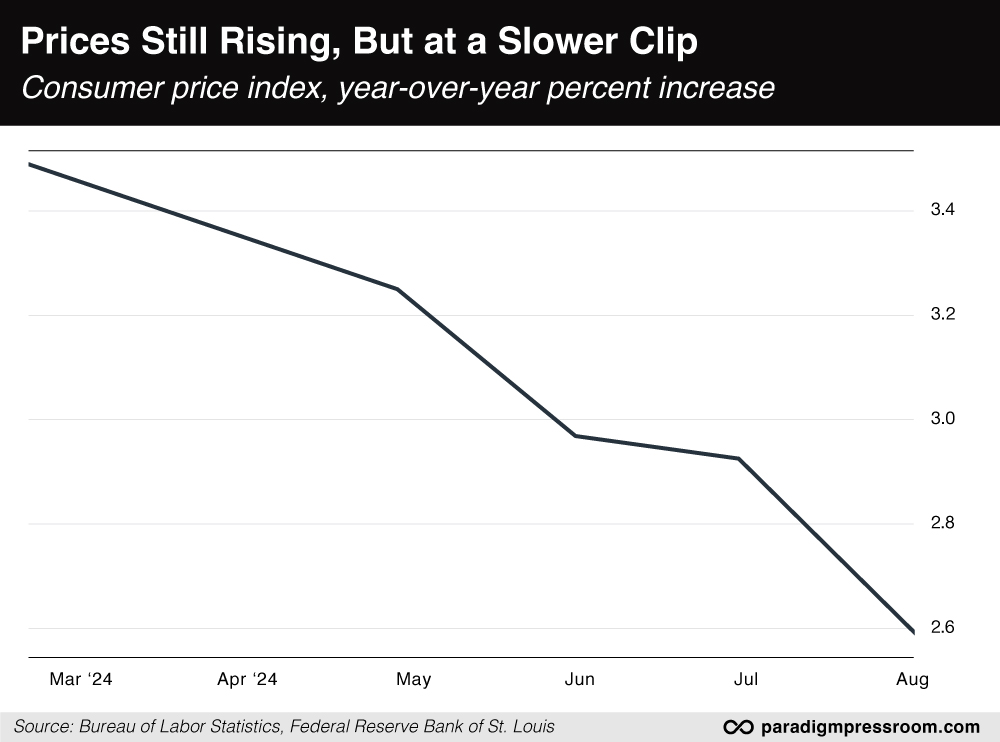
“I am a physicist/mathematician by training,” the reader writes. “I think the graph does not fully illustrate the magnitude of inflation. A graph of total cumulative and compounded inflation over time (say starting in 2020) would be more illustrative. The slope of this curve would always be positive.
“Besides a curve starting in 2020, the article could be expanded to show a curve starting in 1971, the year the U.S. left the gold standard. Also, the year I graduated from high school. Gold was $35 per ounce, gas was $0.20 per gallon, a new car was $5,000 and a home was $15,000. The graph could also include other more accurate measures of inflation than the CPI.
“This article could segue to another article that discusses how the government further benefits from inflation by taxing asset holders for inflation. For example, if an asset appreciates 25% and 20% is due to inflation, the real appreciation (profit) is 5% but a 20% tax on the 25% gain (5%) will wipe out the entire profit.”
Dave responds: All we were trying to do on Thursday was illustrate how the rate of inflation was falling for enough consecutive months that Fed officials felt they had leeway to cut interest rates aggressively.
And as you notice, the title on the chart says “Prices Still Rising.”
But we’ll play along with you, because your points are more than valid. Here’s a raw chart from the Federal Reserve Bank of St. Louis that shows how the price level has risen cumulatively over the last five years…
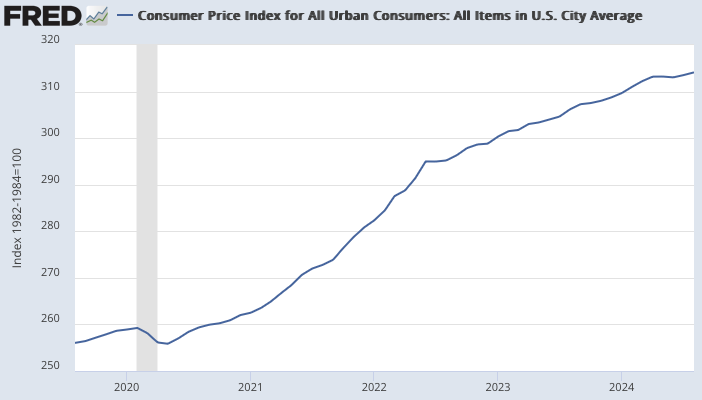
And here’s a chart going back to 1971, when President Nixon closed the gold window…
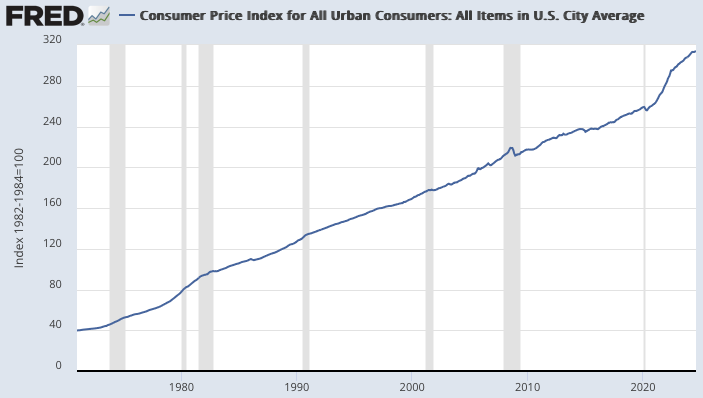
Also, as we can’t emphasize enough, the Labor Department started changing the way inflation was calculated during Ronald Reagan’s first term in the early 1980s.
Result: The official inflation rate peaked this decade at 9.1% in the summer of 2022. But if you ran the numbers the way they were before the Reagan-era changes, the actual peak was 17.3% (per the researchers at Shadow Government Statistics).
And you’re absolutely right about how inflation cuts into your investment returns — and frequently zeroes them out altogether.
Which brings us right back to where we began today. The only way to stay ahead of inflation is with substantial investment returns that outpace both the market and the inflation rate.










